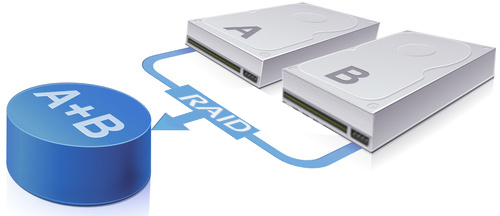In a nutshell, the fundamental technology of digital surveillance storage — the hard drive — is only the beginning of the hardware involved in a storage system.redundancy means using more internal drives than necessary to store the information, or in other words, storing the same data in more than one place. There are many ways to do this, but the most popular is the use of a type of RAID, which can be set up on storage devices with two internal drives or more. That said, the first and foremost thing you should remember is that redundancy is not a form of backup, but just a fail-safe measure. The most popular RAID configurations that offer redundancy are RAID 1 and RAID 5.
Redundancy is not a form of backup, but just a fail-safe measure in case of failure of the storage device’s internal drive or drives.
RAID 1 (which requires at least two drives) uses double the number of drives necessary to store the information. The two drives mirror each other. Thus, only half of the total storage space is available to the user, while the other half is used for redundancy. RAID 5 (which requires at least three drives) uses at most a third more drive(s) than necessary. In RAID 5, what’s available to the user is the combined storage space of all drives used in the array minus one. This way if one drive dies, the rest will kick in immediately and no data is lost.
You can think of redundancy as using two plastic bags, one inside the other, to carry groceries home from the market. This way, if one of the bags is broken or punctured along the way, food, especially broken eggs, won’t spill out.
The biggest and most obvious virtue of redundancy is it protects data against drive failure in real time. This means if you are working on a file and one of the internal drives in a RAID fails, the storage device can continue to work normally. (Some RAID setups can survive when two drives fail.) It will just indicate that one of internal drives has failed, offering you the chance to back up important data and replace the failed drive with another. After that the device itself will blend the replacement drive to become part of the RAID the way the drive it’s replacing used to be, in a process called RAID rebuild. During this time, the storage device is still available to use.
In short, redundancy offers an immediate type of data protection. And since internal drive failures can happen at any time, it’s important to have redundancy for storage devices that host critical information or that provide a service that must not be interrupted.
Last thoughts on redundancy: No matter what type of redundancy RAID you use, remember that it’s just like insurance, something you need to have just in case, and hope that you will never have to resort to. The option to hot-replace a drive should be used only when absolutely necessary and not viewed as a “fun” or “cool” feature. The more often you use this feature, the more likely you are to lose all of your data stored in the storage device. For this reason, when you get a RAID-capable storage device, it’s best to get one that offers lots of storage space to avoid having to replace its internal drives to increase the storage space.
OSI CCTV has a large selection of CCTV IP Cameras and NVRs,HDTVI DVRs (available with redundancy), Complete CCTV Systems, DVRs, Access Control, and Wiring and Accessories. Visit www.OSICCTV.com today! We offer Free Shipping to anywhere in North America with orders over $200, Free Technical Support and have been in business for over 45 Years assuring you that we will always be around to help you with any questions you may have about your product in the future.
Source:

http://www.osicctv.com

